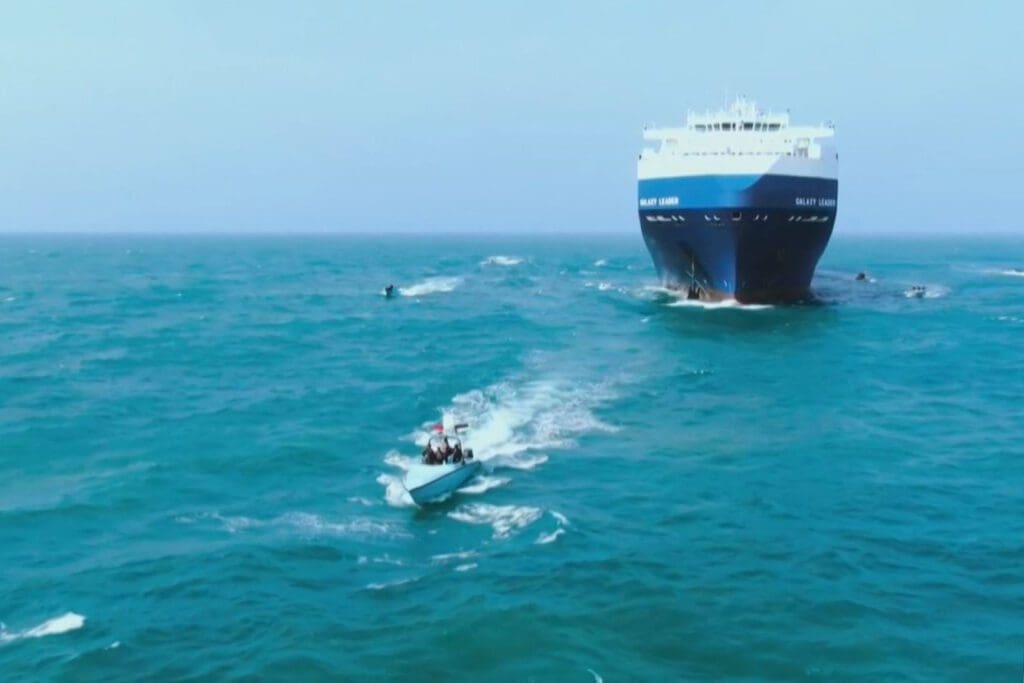When the Yemen-based Houthi movement began attacking commercial shipping in the Red Sea in response to Israel’s war in Gaza, the impact on global trade was almost immediate. The international counter-response led by the United States, however, has only increased the likelihood of intensifying conflict and economic damage. As tensions build, the confrontation in the Red Sea is catalyzing a chain of escalation that may reshape the geopolitical landscape of the Middle East and beyond, including efforts to definitively end Yemen’s own long-running war.
Failed American Strategy
Just weeks into Israel’s bombardment of Gaza in October, the Houthis—otherwise known as Ansar Allah—began attacking vessels linked to Israel in the Red Sea and the Gulf of Aden. As the destruction of Gaza continued, the attacks became increasingly frequent, turning the Bab al-Mandeb straight—a vital conduit for trade between Asia, the Mediterranean and Europe—into a high-risk zone for commercial shipping and sending cargo and insurance costs spiraling.
Initially, the Biden administration sought to avoid a confrontation in the Red Sea to prevent the war in Gaza from spreading across the region. However, as the Houthis escalated, Washington was compelled to intervene in order to counter the group’s threats to shipping at the entrance to the Red Sea, a key route for seaborne energy and commodity shipments. Responding to the economic pressure, the U.S. and Britain mobilized a 20-nation naval coalition in December called “Operation Prosperity Guardian” to ensure freedom of navigation in the waterways, while launching a wave of military strikes against Houthi positions inside of Yemen.
Although American attacks were able to hit Houthi missile and drone platforms, according to the U.S. Department of Defense, such operations will likely not be able to deter or restrain the Houthis indefinitely. On the contrary, they have prompted the group to escalate further. While the Houthis had initially only targeted ships associated with Israel, following the American and British attacks they turned their sights on ships linked to all nations in the naval coalition. This has exacerbated the situation and increased the danger to ships operating in the area. Moreover, the U.S. has treated the issue as disconnected from Gaza and granted Israel unlimited leeway to act, leaving the source of the conflict to fester.
Elsewhere in the region, some of Iran’s proxies have shown reluctance to engage in direct confrontation with the U.S. Iraq’s Ketaib Hezbollah, for instance, announced it would suspend attacks against U.S. forces following U.S. retaliation to the group’s killing of American soldiers on the Syrian-Jordanian border. This will likely only add pressure on the Houthis to continue their operations, however, as the reluctance from other groups shifts focus toward the Red Sea front.
This raises a couple possibilities. First, the Biden administration may continue with its current approach, pressuring the Houthis with retaliatory strikes and implementing sanctions in accordance with its decision to redesignate the group as a terrorist entity. Yet direct confrontation with the U.S. only reinforces the group’s ideological stance and grants it legitimacy, which it craves both locally and regionally, and may lead the Houthis to intensify their attacks against Western targets to provoke a more aggressive reaction from Washington.
It is also possible that the U.S. gradually expands military operations. But such an approach could also have significant negative consequences. For one thing, it could force the closure of the port of Hodeidah in Yemen, which would exacerbate the already-horrendous humanitarian and economic situation in the country. It would also likely force the Houthis to engage in a comprehensive war, hindering the ongoing peace talks in Yemen with parties to the conflict like Saudi Arabia. Despite reports indicating Riyadh’s determination to complete the ceasefire process in Yemen, events like the situation in Gaza have delayed the signing process. For the time being, as long as Saudi Arabia does not join the international coalition against the Houthis, the prospects for a peace agreement in Yemen remain viable. But a decision to escalate from the U.S. could derail that.
Economic Repercussions
The strategic significance of the Red Sea as an artery for maritime trade has amplified the economic impact of the Houthis’ attacks. While initially aimed at exerting pressure on the Israeli economy, the subsequent expansion of targets has had repercussions across international maritime trade, foreshadowing profound consequences for the broader global economy as the spike in shipping costs risks fanning already high inflation.
Beyond Israel, whose maritime trade via Eilat Port is almost paralyzed, Europe’s increased dependence on the Gulf for its energy needs following Russia’s invasion of Ukraine rendered it vulnerable to supply chain disruptions. Major Asian economies, both significant oil importers and commodity exporters, are growing weary.
As the attacks persist, many major shipping companies were forced to suspend operations in the Red Sea or to re-route ships via the Cape of Good Hope. The longer routes and higher costs they entail—both in fuel and labor—have already started to exacerbate shipping costs. According to Freightos, a booking and payment platform, shipping container rates from Asia to the Mediterranean have tripled. Meanwhile, daily traffic through the Suez Canal has decreased by 45%, with grim implications for Egypt’s struggling treasury.
The United Nations Conference on Trade and Development (UNCTAD) has expressed its concern over trade disruptions and warned of the price hikes they can cause, especially in energy and food markets. This comes as the global economy had just started to recover from the shocks of the coronavirus pandemic and the conflict in Ukraine.
In the Middle East and North Africa, inflationary pressures pose a major threat to states that are highly dependent on food imports and vulnerable to price shocks. The region already grapples with food insecurity attributed to the scarcity of water and arable land, which is being further exacerbated by climate change. And despite a slight easing of international food prices in 2023, several MENA states still face shortages of staples due to their depreciating currencies, a scarcity of foreign currency, and an inability to meet upfront payments. Traditionally, countries such as Egypt and Tunisia have relied on subsidies to mitigate the pass-through of global price fluctuations. Now they are struggling to do so given mounting public debt and pressure from international financial institutions for subsidy reform.
All this comes as several devastating humanitarian crises are unfolding in the region at once—in Sudan, Gaza and, of course, Yemen itself. Some 21.6 million Yemenis required humanitarian assistance and 17 million were food insecure in 2023. Ironically, part of this is due to higher shipping costs resulting from the cost of war insurance. The recent escalations and the re-designation of the Houthis as a terrorist group risk further compounding the humanitarian crisis, as aid operations and funding are compromised. Consequently, the country has little ability to absorb the potential impact of higher prices.
The disruptions in the Red Sea, along with the fresh outbreaks of violence elsewhere in the region, will thus magnify the misery for MENA economies already hit by inflation. This could easily act as a catalyst for more social unrest, particularly given the limited fiscal spaces and the mounting geopolitical tensions in the region. If things continue to escalate, the crisis in the Red Sea will have consequences well beyond its narrow waterways.



